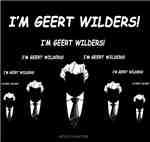The New Stuff of Fabulous Fab
PJM: "Manufacturing on Demand: The Future Is Now", by Charlie Martin
Computer and internet technology is bringing big changes to daily life: music distribution without the need for big physical production plants, electronic book publishing, and even what the continuing advances in computer technology will mean to computers themselves. All of these changes really come down to one central idea: increasingly the real product is information, not a physical object built around that information. (...)
 Now, it happens that I have on my desk a lovely little object (...) made by my old friend Bathsheba Grossman, a mathematical sculptor, using a 3D printing process. Imagine, just for a second, how your regular ink-jet printer works. (...) The print head scans across the paper, and the platen moves the paper upward; every place the paper should be black, the print head spits a tiny dot of waxy black ink at the paper. If you keep going back and forth over the paper, you can imagine how the waxy ink would build up to be thicker and thicker.
Now, it happens that I have on my desk a lovely little object (...) made by my old friend Bathsheba Grossman, a mathematical sculptor, using a 3D printing process. Imagine, just for a second, how your regular ink-jet printer works. (...) The print head scans across the paper, and the platen moves the paper upward; every place the paper should be black, the print head spits a tiny dot of waxy black ink at the paper. If you keep going back and forth over the paper, you can imagine how the waxy ink would build up to be thicker and thicker.
These metal objects are “printed” in much the same way, except to make them of metal, the “ink” is a kind of resin “glue” that sticks together fine metal powder. Later, the metal objects are heated, which drives off the glue and bonds the metal, a process called “sintering.” Sheba then does a few manual finishing steps, but the result is an object that really can’t be made by any other method — and it comes off the printer in a matter of hours. (...)
This notion of quickly turning a digital description into a physical object is becoming known as “rapid prototyping,” with a range of possible technologies: numerically-controlled machining, various kinds of “3D printing” like Sheba uses, even numerically controlled woodworking. (You can find a nice summary of the different technologies at the University of Utah Rapid Prototyping Home Page, and this Rapid Prototyping tutorial page.)
 We’re pretty much at the MITS 8800 stage of manufacturing on demand — there’s no guessing which technologies will come out to be the winners. But we can make some guesses what the eventual results will be, if we just think about what the computer revolution has already done. (...)
We’re pretty much at the MITS 8800 stage of manufacturing on demand — there’s no guessing which technologies will come out to be the winners. But we can make some guesses what the eventual results will be, if we just think about what the computer revolution has already done. (...)
If you want a particular style of fork and can find it on the Internet, you can have it: send it to a fabrication company (or maybe even have your own at-home 3D printer — you can already make a do-it-yourself version, like the Fab@Home project) and within hours or days you have your fork. If you have a design for a fork, you can sketch it with something like Sketch-Up, advertise it and sell it. No need to have a factory, no need to pitch it to a big company, no need to share the rights. (...)
What will it mean when everyone can be a designer and a manufacturer, just as computer technology lets everyone be a publisher, or cut and sell a record?
Start thinking about it. The time is coming. >>>














No comments:
Post a Comment